Heat Rash vs. Eczema: How to Tell the Difference

A rash is any area of irritated or swollen skin on your body. Rashes are often itchy and painful and can appear differently on different skin tones. Common causes of rashes are heat rash and eczema.
Heat rash is a skin irritation caused by excessive sweating during hot, humid weather. It causes small red spots in places where sweat collects.
Causes of heat rash are:
Blockage and inflammation of sweat ducts in heat and humid weather. Many factors cause sweat glands to clog, including:
- Small pieces of dead skin cells (skin secretions) block your gland.
- Too much sweat builds up between your skin and your clothing.
- Hair follicles block your glands.
- Hormone changes; like being on your period.
- Not enough airflow between your skin and clothing.
Newborn babies as their glands haven’t matured yet.
Symptoms are small blisters, irritating rash, prickling sensation, and redness and swelling of the affected area. The good news is that heat rash is usually not serious, and it generally doesn’t last too long.
Eczematous rash is a condition that causes your skin to become dry itchy and bumpy. This condition weakens your skin’s barrier function, which is responsible for helping your skin retain moisture. Causes are dry weather, skin products, and allergens (smoke, metal objects, clothing).
Symptoms are raised bumps, rash, oozing, itchiness, crusting, and dry cracked skin.
Heat rash
When sweat collects on areas such as the armpits, back, under the breasts, chest, groin, elbow creases, back of the knees, and the waist due to blockage of sweat gland ducts small red spots develop there that lead to the formation of rash.
There are three types of heat rash:
Miliaria Crystallina

A person’s back showing symptoms of Miliaria Crystallina, characterized by numerous small, clear blisters resembling beads of sweat. Patchy reddish inflammation on the skin
Miliaria crystallina is the mildest kind of heat rash. It happens when the opening of the sweat duct on the skin’s surface (sweat pore) gets blocked. This type is distinguished by small, transparent, fluid-filled bumps that readily rupture.
Miliaria Rubra
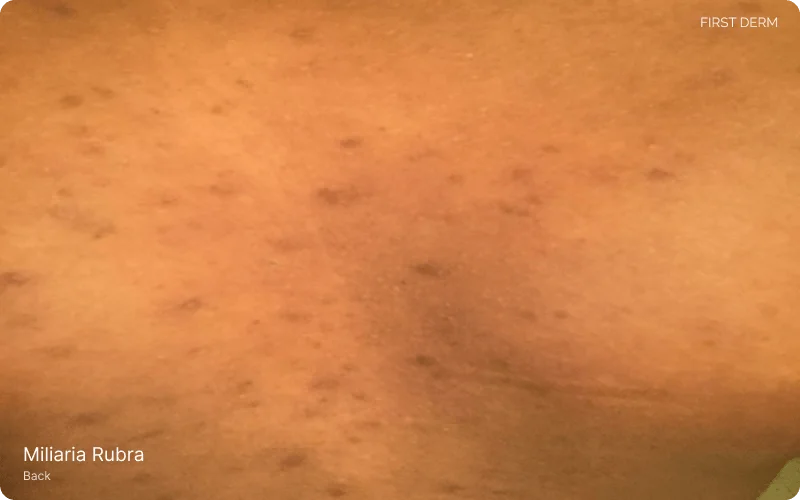
Person’s back afflicted with Miliaria Rubra, showcasing the discomforting red bumps of prickly heat
Miliaria rubra is a kind that occurs deeper in the skin. Prickly heat is another name for it. Small, irritated blister-like lumps and stinging or prickling in the affected region are signs and symptoms.
Miliaria Profunda
Miliaria profunda is a less prevalent kind of heat rash. This is the most severe type of heat rash, but it’s also the least common. It often happens after a period of prolonged exercise when you sweat more than usual. If the sweat gets trapped in your skin, you may develop a series of larger, firm, reddish-colored bumps. It affects the skin’s deepest layer (dermis). It generates hard, painful, or itchy inflamed pimples that resemble goose bumps and can rupture.
Eczema
Eczema, also known as “atopic dermatitis,” is a noncontagious, inflammatory skin condition that is characterized by severe itching, redness, oozing, and scaly rashes(1). These symptoms can be painful and can cause changes in skin color and blisters. Atopic dermatitis is characterized by dry, itchy skin. The color of the rash tends to be:
- reddish in people with lighter skin tones
- brown or gray in people with darker skin
Types of eczema are:
Atopic dermatitis
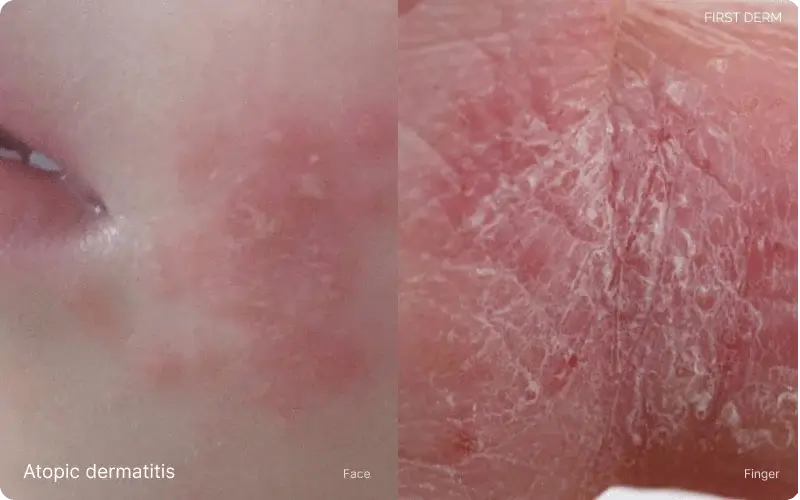
Atopic dermatitis symptoms in two separate locations on a person: the face and the finger
Prolonged hypersensitivity to environmental allergens (pollens and dust mites) leads to its development. Atopic eczema is extremely itchy and scratching accounts for the sign like lichenification.
Seborrheic dermatitis
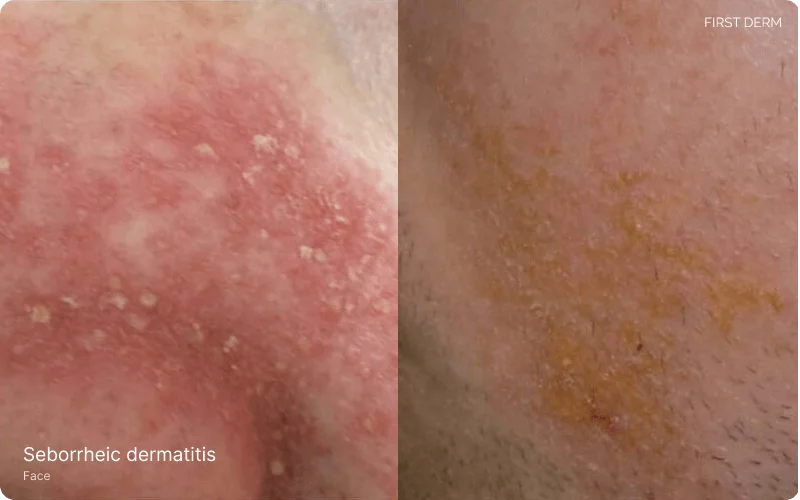
Seborrheic Dermatitis, particularly located at the nasolabial folds, marked by inflamed, reddish skin with flaky white patches. The second image on right reveals yellowish patches or scales on the face
Also known as Dandruff Eczema. Erythematous scaly rash affecting the scalp, central face, and nasolabial folds. It may be due to yeast Malassezia. It may mimic psoriasis.
Discoid Eczema
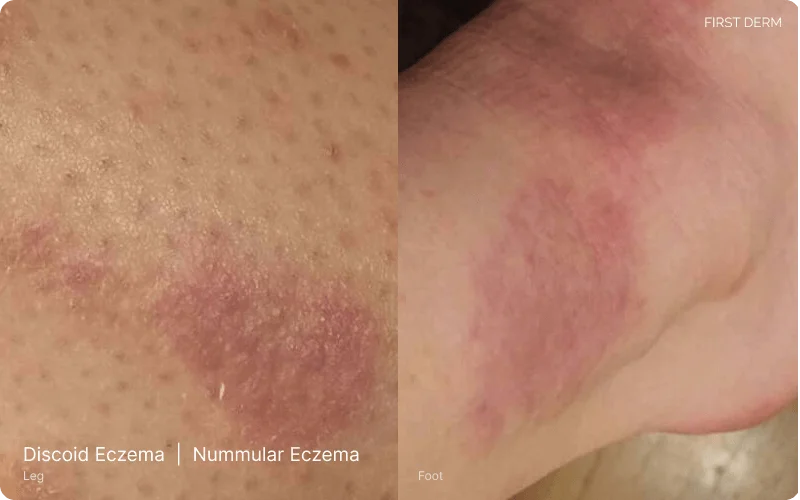
A clear depiction of Discoid or Nummular Eczema, with its distinct round or oval patches of inflamed, itchy, and scaly skin on the leg
Characterized by coin-shaped lesions commonly on the limbs of man.
Irritant Eczema

Irritant Eczema on a leg, characterized by redness, inflammation
The main causes of Irritant Contact Dermatitis are Irritants such as acids, alkalis, detergents, and solvents. They cause chronic eczema, especially in the hands.
Neurodermatitis
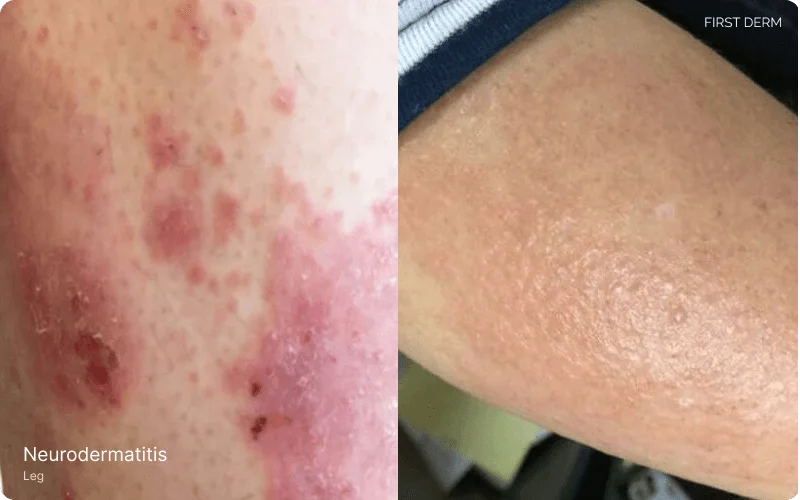
Neurodermatitis | Left: characterized by rough, leathery patches of skin that are intensely itchy. Right: reddish patch of skin on the leg in the primary stages of Neurodermatitis
Also known as Lichen Simplex Chronicus, this type of eczema starts with one or two itchy patches of skin that get itchier and itchier. Repeated scratching can make the skin thicker (but usually still itchy).
Allergic Contact Eczema
Delayed hypersensitivity response to allergens. Ezema occurs at the site of contacts such as earlobes, wrists, and umbilicus due to nickel in earnings, watches, and jeans studs. hands and wrists due to rubber gloves. Edema may also be a feature. Also known as Contact dermatitis
Asteatotic Eczema
This occurs in dry skin. Low humidity caused by heating, overwashing, and dryness leads to this type. The most common site is the lower legs and a crazy pavy pattern of fissuring on an erythematous back is seen.
Gravitational Eczema
Also known as stasis eczema mainly occur on the lower legs with signs of venous insufficiency edema, loss of hair, induration, and lipodermatosclerosis. Emollients and topical steroids may be used.
How to differentiate between heat rash and eczema
Identifying heat rash
| Causes: Hot and humid conditions. |
| Trigger Factors: Early childhood, physically active, tropical climates, and overheating. |
| Duration: Symptoms last 2-3 days. |
| Severity: They usually go away within a few days |
| Location: under the breasts, chest, groin, elbow creases, back of the knees, and the waist. |
| Treatment: Prickly heat, calamine lotion, and antihistamines. |
Identifying eczema
| Causes: Different causes according to type can be dryness, allergens, and dandruff. |
| Trigger Factors: Irritants such as soaps, detergents, metal jewelry, mites, pollens, and dust. |
| Duration: Symptoms may last up to 3 weeks. |
| Severity: EASI score is used to measure the severity. A score of 0 indicates clear or no eczema, 0.1 to 1.0 indicates almost clear, 1.1 to 7 indicates mild disease, 7.1 to 21 indicates moderate disease, 21.1 to 50 indicates severe disease, and greater than 51 indicates very severe disease. |
| Location: Varies according to the type of eczema. Eczema can appear anywhere, but it often develops behind the knees, in the inner part of the elbows, on your hands, and on your scalp and head. |
| Treatment: Avoidance of risk factors and treatment according to the type. |
If you experience any severe symptoms of a heat rash, contact your healthcare provider. Severe symptoms include:
- Pain.
- Intense itching.
- Rash feels warm to the touch.
- Rash becomes infected (leaks pus or fluid, swelling, fever, nausea).
- Rash doesn’t go away after at-home treatment or persists for longer than a week.
Treatment of heat rash
Cooling the skin and minimizing exposure to the heat that produced the disease are the treatments for moderate heat rash. Mild heat rash usually clears up fast once the skin has cooled down.(2)
To help protect yourself or your child from heat rash:
- Dress in loose, lightweight clothing that evaporates sweat away from the skin in hot weather.
- Avoid wrapping neonates in too many layers.
- Limit physical activities in hot temperatures. Stay in the shade or an air-conditioned structure. Alternatively, use a fan to circulate the air.
- Maintain a cool and well-ventilated sleeping environment.
- Creams and ointments that might clog pores should be avoided. (2)
- Avoid sweat-inducing medications such as clonidine, beta-blockers, and opioids.
Treatment of eczema
In cases of moderate or severe eczema, an allergist may recommend prescription medication, including topical steroids and/or antihistamines.
Milder cases may be treated with ointments, such as petroleum jelly, and moisturizers. Those should be applied daily, even when the skin appears clear, to help prevent dryness. (3)
Apart from steroids and antihistamines, the patient may also be prescribed phototherapy UVA and UVB.
Patients may also need immunosuppressive drugs such as dupilumab. As of 2022, the drug, dupilumab, has been approved for children down to 6 months. Dupilumab is used to treat adults and children 6 months of age and older with moderate-to-severe eczema that is not well controlled with prescription therapies used on the skin (topical), or who cannot use topical therapies. Dupilumab can be used with or without topical corticosteroids(4).
How to prevent eczema
First, try to figure out what your specific triggers are, and then do your best to avoid them. Other steps you can take to try and prevent an eczema flare-up include the following (5):
- Avoid using highly perfumed soaps and detergents since they might hurt your skin.
- Keep allergens like dust, pollen, mold, and pet dander out of your house.
- Maintain a healthy degree of stress.
- Instead of hot baths or showers, use lukewarm ones.
- In the tub or shower, avoid exfoliating your skin.
- On a hot day, choose a space in the shade to keep cool.
- Wear sunscreen and protective clothing when going outside.
The bottom line
It might be difficult to tell whether you have a heat rash or eczema in newborns, children, and even adults.
If you’re not sure, get yourself or your child out of the heat and into a cooler atmosphere and see how the skin reacts. If the rash improves in a day or two, it is most likely a heat rash.
If the rash persists or you notice additional symptoms, consult your doctor for a proper diagnosis and treatment. Self-medication is harmful as treatment of one disease might worsen the other so it’s better to consult your doctor so that he can make a proper diagnosis and give treatment according to the disease.
Disclaimer
The information contained in this article is for general informational purposes only. It is not intended to diagnose, treat, cure, or prevent any disease or health condition. If you have any concerns or questions about your skin, you should always consult with a dermatologist or other qualified health care professional.
References
- Nemeth V, Evans J. Eczema. In Treasure Island (FL); 2023.
- Frazier W, Bhardwaj N. Atopic Dermatitis: Diagnosis and Treatment. Am Fam Physician. 2020 May;101(10):590–8.
- Olabi B, Williams HC. Evidence-based management of eczema: five things that should be done more and five things that should be dropped. Curr Opin Allergy Clin Immunol. 2021 Aug;21(4):386–93.
- Lee JH, Son SW, Cho SH. A Comprehensive Review of the Treatment of Atopic Eczema. Allergy Asthma Immunol Res. 2016 May;8(3):181–90.
- Peate I. Eczema: causes, symptoms and treatment in the community. Br J Community Nurs. 2011 Jul;16(7):324,326-331.
Ask a Dermatologist
Anonymous, fast and secure!

The Specialist doctor from the University Hospital in Gothenburg, alumnus UC Berkeley. My doctoral dissertation is about Digital Health and I have published 5 scientific articles in teledermatology and artificial intelligence and others.

